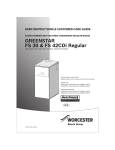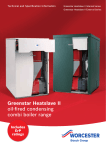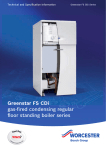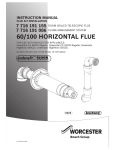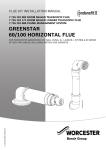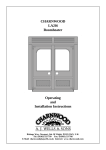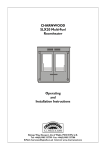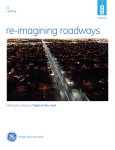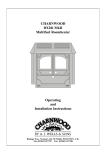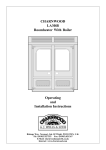Download Worcester GREENSTAR FS 42CDi Regular Installation manual
Transcript
INSTALLATION INSTRUCTIONS 7 716 191 159 ROOM SEALED FLUE 80MM FLEXIBLE FLUE SYSTEM Only for use with Worcester appliances: Greenstar FS 30CDi Regular and Greenstar FS 42CDi Regular 8 716 115 519a (2009/03) UK/IE the nation’s favourite for PLUMBING & HEATING SUPPLIES FREE SHIPPING SECURE PAYMENTS on all orders over £100 to mainland UK shop online with confidence FINANCE AVAILABLE PRICE MATCH spread the cost with low interest rates always get the best deals available we have H U G E R E D U C T I O N S ON THOUSANDS OF ITEMS Boilers Bathroom suites Radiators Kitchen sinks & taps Heating controls Showers Pipes & ittings Wet rooms Cylinders Towel warmers Fires Bathroom furniture Renewable energy & much more visit our website plumbnation.co.uk CALL US ON 0844 800 3460 CONTENTS CONTENTS 1 EXPLANATION OF SYMBOLS AND SAFETY PRECAUTIONS . . . . . . . . . . . . . . . . . . . . 3 1.1 Explanation of symbols . . . . . . . . . . . . . . . 3 1.2 Safety precautions . . . . . . . . . . . . . . . . . . 4 2 INSTALLATION REGULATIONS . . . . . . . . . . . . . . 5 3 PRODUCT INFORMATION . . . . . . . . . . . . . . . . . 6 3.1 Flexible flue components . . . . . . . . . . . . . 6 3.2 Flue extension components . . . . . . . . . . . 7 4 PRE-INSTALLATION . . . . . . . . . . . . . . . . . . . . . . 8 4.1 Flexible flue terminal positions . . . . . . . . . 8 4.2 Installation clearances . . . . . . . . . . . . . . . 9 4.3 Requirements for the chimney . . . . . . . . . 9 4.4 Preparing the chimney . . . . . . . . . . . . . . . 9 4.5 Calculating the effective flue length . . . . 10 5 INSTALLATION . . . . . . . . . . . . . . . . . . . . . . . . . 5.1 Creating the chimney hole . . . . . . . . . . . 5.2 Installing the support elbow . . . . . . . . . . 5.3 Assembling the flexible flue . . . . . . . . . . 5.4 Installing the flexible liner assembly . . . . 5.5 Installing the flue terminal . . . . . . . . . . . 5.6 Converting the flue outlet . . . . . . . . . . . . 5.7 Fitting the flue adaptor . . . . . . . . . . . . . . 5.8 Extensions and elbows . . . . . . . . . . . . . . 5.9 Fitting the horizontal flue . . . . . . . . . . . . 6 SERVICING AND SPARES . . . . . . . . . . . . . . . . . 26 6.1 Servicing . . . . . . . . . . . . . . . . . . . . . . . . . 26 6.2 Spare parts . . . . . . . . . . . . . . . . . . . . . . . 27 2 11 11 12 13 16 19 20 21 22 24 8 716 115 519a (2009/03) EXPLANATION OF SYMBOLS AND SAFETY PRECAUTIONS 1 EXPLANATION OF SYMBOLS AND SAFETY PRECAUTIONS 1.1 EXPLANATION OF SYMBOLS WARNING SYMBOLS Safety instructions in this document are framed and identified by a warning triangle which is printed on a grey background. Electrical hazards are identified by a lightning symbol surrounded by a warning triangle. Signal words indicate the seriousness of the hazard in terms of the consequences of not following the safety instructions. • NOTICE indicates possible damage to property or equipment, but where there is no risk of personal injury. • CAUTION indicates possible personal injury. • WARNING indicates possible severe personal injury. • DANGER indicates possible risk to life. IMPORTANT INFORMATION Notes contain important information in cases where there is no risk of personal injury or material losses and are identified by the symbol shown on the left. They are bordered by horizontal lines above and below the text. ADDITIONAL SYMBOLS Symbol Meaning B step in an action sequence å reference to a related part in the document or to other related documents • list entry – Ø list entry (second level) Diameter Cutting required Drilling required Table 1: 8 716 115 519a (2009/03) 3 EXPLANATION OF SYMBOLS AND SAFETY PRECAUTIONS 1.2 SAFETY PRECAUTIONS PLEASE READ THESE INSTRUCTIONS CAREFULLY BEFORE STARTING INSTALLATION: These installation instructions are applicable to the Worcester flue kit stated on the front cover of this manual and must not be used with any other make or model. These installation instructions must be read in conjunction with the appliance manual. The instructions apply in the UK/IE only and must be followed except for any statutory obligation. This flue kit must be installed by a CORGI registered, competent person. Failure to install correctly could lead to prosecution. If you are in any doubt contact the Worcester technical helpline. Distance learning and training courses are available from Worcester. FITTING AND MODIFICATIONS: Fitting the flue system to the appliance must be carried out by a CORGI registered, competent person in accordance with these installation instructions and the current Gas Safety Regulations (Installation and Use). Worcester, Bosch Group recommends that this flue system is installed by two persons for easier handling of the components. Flue systems must not be modified in any way other than as described in the fitting instructions. Any misuse or unauthorised modifications to the appliance, flue or associated components and systems will invalidate the warranty. The manufacturer accepts no liability arising from any such actions, excluding statutory rights. B Position the flue terminal in such a way so that combustion products do not enter the building or cause a nuisance. B Position the flue in such a way so the flue does not cause an obstruction. BENCHMARK: Please leave these instructions with the completed Benchmark checklist (or a certificate confirming compliance with IS 813, EIRE only) with the owner after installation or servicing. The Benchmark checklist can be found in the back two pages of the appliance installation manual. IF YOU SMELL GAS: B Do not smoke or strike matches. B Do not turn electrical switches ON or OFF. B Put out naked flames. B Open doors and windows. B Keep people away from the affected area. B Turn off the control valve at the meter. B Call your gas company. B Ensure the flue terminal is not obstructed and combustion products can discharge without hindrance. B Fit the flue according to the regulations and standards stated on page 5. SERVICING: Advise the user to have the system serviced annually by a CORGI registered, competent person using approved spares, to help maintain the economy, safety and reliability of the appliance. B The service engineer must complete the Service Record on the Benchmark Checklist after each service. OR B Call emergency number 0800 111 999. USE This flexible flue system is only suitable for lining chimneys that conform to the building regulations. B Do not use this flexible flue as a chimney on its own. B Do not use this flexible flue outside a masonry or flueblock chimney. WORKING AT HEIGHTS: B Refer to the applicable health & safety regulations. 4 8 716 115 519a (2009/03) INSTALLATION REGULATIONS 2 INSTALLATION REGULATIONS Current Gas Safety Regulations (Installation and Use): Failure to install flue systems correctly could lead to prosecution. All flue systems and associated components must be installed by a CORGI registered, competent person in accordance with the following regulations. Relevant regulations: • Gas Safety Regulations 1998 (Installation and Use) • Building Regulations • Building Regulations (Northern Ireland) • Building Standards (Scotland) (Consolidation) • IS 813 (Eire) • IGE “Gas Installation in Timber Frame Buildings” • Any other local requirement The relevant British Standards to be followed, include: BS5440: 1 Flues and ventilation for gas appliances of rated input not exceeding 70kW (net): Flues BS5440: 2 Flues and ventilation for gas appliances of rated input not exceeding 70kW (net): Air Supply BS6798: 2000 Specification for installation of gas fired boilers of rated input not exceeding 70kW net Table 2: Relevant British Standards If no specific instruction is given, refer to the British Standard Codes of Practice. 8 716 115 519a (2009/03) 5 PRODUCT INFORMATION 3 PRODUCT INFORMATION 3.1 FLEXIBLE FLUE COMPONENTS No. Description Quantity 1 Flue terminal 1 2 Chimney cowl 1 3 Self-adhesive weather seal 1 4 Terminal adaptor 1 5 Support bracket assembly 1 6 Liner 2 7 Seal 2 8 Flexible liner 1 9 Centralising spacer 4 10 Support elbow adaptor 1 11 Support elbow 1 12 Elbow support 1 13 Flue inspection plates 2 14 Seal for flue inspection plates 1 15 125mm flue extension 1 16 Tee piece 1 17 125mm flue connector 1 18 80/80mm flue adaptor 1 Table 3: 6 Contents of package 8 716 115 519a (2009/03) PRODUCT INFORMATION 3.2 FLUE EXTENSION COMPONENTS Ø 80/125 1000mm Extension kit (Part No: 7 719 001 892) 1 Extension tube assembly Table 4: Extension kit contents Ø 80/125 90° bend (Part No: 7 719 001 891) 2 90° bend Table 5: 90°bend contents Ø 80/125 45° bends (Part No: 7 719 001 899) 3 45° bend x2 Table 6: 45° bends contents Fig. 1 8 716 115 519a (2009/03) Extension components 7 PRE-INSTALLATION 4 PRE-INSTALLATION NOTICE: Risk of damage to the appliance or flue. B Read all Pre-Installation sections. B Ensure all requirements are met before using the appliance or flue installation. 4.1 FLEXIBLE FLUE TERMINAL POSITIONS Flue gases have a tendency to plume and in certain weather conditions a white plume of condensation may be discharged from the flue outlet. Where this could cause a nuisance, for example near security lighting, an alternate flue position should be found. Fig. 2 The flue terminal positions must also follow those stated in the relevant appliance installation manual. Flexible flue terminal positions and clearances Minimum clearances 1 500mm to non-combustible building material or 1,500mm to combustible building material 2 600mm to another vertical flue terminal 3 600mm above and to either side of a Velux window and 2,000mm below a Velux window 4 1500mm above and to either side of a Dormer window 5 400mm to a pitched roof (500mm in regions with heavy snow fall) Table 7: 8 Minimum clearances 8 716 115 519a (2009/03) PRE-INSTALLATION 4.2 INSTALLATION CLEARANCES For information regarding installation clearances please refer to the appliance installation manual. 4.3 REQUIREMENTS FOR THE CHIMNEY CHIMNEY SIZE Before starting with the flue installation: B Ensure the cross section of the chimney complies with table 8 below and figure 3 opposite. cmin cmax Ø dmin Ø dmax 130mm 300mm 146mm 300mm Table 8: Fig. 3 Chimney sizes Chimney sizes FIRE RESISTANCE The materials used for the construction of the chimney must be fire resistant in compliance with the figures stated below. Type of building Fire resistance single storey building 30 minutes multi storey building 90 minutes Table 9: 4.4 Fire resistance of chimney material PREPARING THE CHIMNEY • The chimney must be swept if it has been previously used for an appliance burning a fuel other than gas. • It is recommended that the chimney be swept before installation of the flexible flue. • Any damper or restrictor plate in the chimney must be removed. If it is not possible to remove the sliding damper it must be fixed permanently in the open position. • Any holes in the chimney must be sealed. • The existing chimney pot and flaunching must be removed. • The catchment space (void below the point of flue connection) must be checked to ensure it complies with the flue to be installed. • All debris must be cleared from the catchment space. • To avoid debris falling into the air inlet duct, do not install the duct with the open end facing up the chimney. Only one appliance can be fitted to the flexible flue system. 8 716 115 519a (2009/03) 9 PRE-INSTALLATION 4.5 CALCULATING THE EFFECTIVE FLUE LENGTH appliance variant max flue length vertical (Lvmax) max flue length horizontal (Lhmax) FS 30CDi 12m 3m FS 42CDi 12m 3m Table 10: Maximum flue length To calculate the effective flue length: B Check the flue path and consider the following: – number of 90° and 45° elbows required outside the chimney – number of bends in the flexible liner B Deduct the effective length of each elbow from the maximum horizontal flue length of 3m. 80/125 mm elbow Effective length (m) 90° 2m 45° 1m Table 11: Elbow equivalent lengths B Deduct the effective lengths of each bend from the maximum vertical flue length (Lvmax) of 12m. Bend in 80mm flexible liner Effective length (m) 45° 1.5m Table 12: Bend equivalent lengths Fig. 4 Maximum flue length EXAMPLE OF EFFECTIVE FLUE LENGTH CALCULATION (FOR FIGURE 4) This example shows the use of the flexible flue kit without additional extensions or elbows. Horizontal effective flue length (no extensions or elbows) Lh = 1m Lh ≤ Lhmax ? Lhmax = 3m OK Tab. 13: Example: horizontal flue length Vertical effective flue length (with 2x 45° bends) Lvmax = 12m - 2x 45° bend = 3m Lv ? = 9m Tab. 14: Example: vertical flue length 10 8 716 115 519a (2009/03) INSTALLATION 5 INSTALLATION 5.1 CREATING THE CHIMNEY HOLE WARNING: To avoid debris falling into the air inlet duct, do not install the duct with the open end facing up the chimney. The horizontal flue pipe connecting appliance and flexible liner must rise by at least 52mm for every metre of length. This is to ensure the condensate flows back into the appliance. B Ensure the lower edge of the chimney hole is higher than the appliance. As shown in fig. 5, the height h is dependant on the distance d. For every metre the appliance is away from the chimney wall the height must rise by at least 52mm. The further away the appliance stands from the chimney wall, the higher the lower edge of the chimney hole must be. The chimney hole must be large enough to install the flue and allow access to the joints for servicing. B Make an opening in the chimney wall according to the measurements shown in fig. 6. B Mark the position of elbow support, ensuring that the mark is centred within the opening made in the chimney wall. B Drill a Ø 10mm hole 60mm deep into the chimney wall. Fig. 5 Positioning the chimney hole Fig. 6 Chimney hole An additional hole is required to secure the support bar. B Drill a hole into the ledge of the chimney hole as shown opposite, ensure that the hole is centrally located in the opening. B Insert a suitable wall plug. = Fig. 7 8 716 115 519a (2009/03) = Drilling securing hole 11 INSTALLATION 5.2 INSTALLING THE SUPPORT ELBOW Depending on the depth of the chimney, it may be necessary to cut the support bar. B Cut the support bar to fit the chimney as in fig. 8. B Drill a new hole into the support bar. Ensure it will match with the securing hole in the ledge. Fig. 8 Cutting the support bar Fig. 9 Fitting the elbow onto the elbow support B Measure the depth of the chimney. B Position the elbow centrally on the elbow support as shown in fig. 9. B Secure with the wing nut. B Grease the seal in the elbow. B Place the elbow assembly in the chimney. B Ensure that the elbow support is horizontal and the elbow centrally positioned with the chimney space. B Secure the assembly with a screw as shown in fig. 10. Fig. 10 Placing the elbow assembly into the chimney 12 8 716 115 519a (2009/03) INSTALLATION 5.3 ASSEMBLING THE FLEXIBLE FLUE B Use a hack saw. B Cut the flexible liner off square directly below a set of ridges. B Do not cut between the individual ridges of a set. Fig. 11 Where to cut the flexible liner 1. Remove the liner and seal from the adaptor. 2. Remove the seal (b) from the liner (a). a b Fig. 12 Removing liner and seal from adaptor 3. Use a screwdriver to release the locking tab. 4. Rotate the moveable band anti-clockwise to open the bayonet release. Fig. 13 Opening the bayonet release 8 716 115 519a (2009/03) 13 INSTALLATION 5. Fit the seal (b) into the first wide recess on the flexible liner (c). Make sure the seal (b) is not twisted and is seated properly. 6. Fit the liner (a) into the flexible liner (c). 7. Grease the seal (b). b c a b Fig. 14 Fitting the seal and liner 8. Push the adaptor onto the flexible liner until it “bottoms out” and the moveable band “clicks” into place. If the band does not “click” into place, check: B the adaptor is pushed down fully B the adaptor is square to the flexible liner B the lugs are aligned with their slots in the adaptor B that the flexible liner is cut correctly B refer to fig. 16 for help 9. Rotate the moveable band clockwise until it locks in place. Fig. 15 Fitting the adaptor onto the flexible liner Fig. 16 Cutaway view of adaptor fitted to flexible liner 14 8 716 115 519a (2009/03) INSTALLATION The centralising spacer must be shortened to fit the 80mm flexible liner. 10. Snap off the centralising spacer at the perforated section marked 80mm to suit the flue. Fig. 17 Shortening the centralising spacer 11. Secure the centralising spacer around the flexible liner as shown in fig. 18. Fig. 18 Fitting the centralising spacer The centralising spacers must be fitted to the flexible liner in certain positions to ensure the liner is centred within the chimney. B For a chimney with a bend place the centralising spacers at positions shown opposite. B Place a centralising spacer at least every 2500mm on the vertical parts of the chimney. Fig. 19 Positioning the centralising spacers 8 716 115 519a (2009/03) 15 INSTALLATION 5.4 INSTALLING THE FLEXIBLE LINER ASSEMBLY To ease the assembly of the flue components: B Grease all seals lightly with solvent-free grease . B Ensure all seals are seated properly and are in good condition. 1. Feed the flexible liner assembly into the chimney from the top. 2. Insert the adaptor into the support elbow. Fig. 20 Feeding the liner assembly into the chimney 16 8 716 115 519a (2009/03) INSTALLATION 3. Fit the support collar onto the flexible liner. Ensure the retaining ring at the top of the collar is seated in a ring of the corrugated section as shown opposite. 4. Assemble the support bracket onto the support collar. In order to install the terminal adaptor, there must be at least three corrugated sections of the flexible liner left above the support bracket assembly. Fig. 21 Fitting support collar and support bracket The flexible flue must be centrally aligned within in the chimney. 5. Mark the support bracket fixing points. Drill the fixing points. Secure the support bracket to the chimney. Fig. 22 Fixing support collar to chimney top 8 716 115 519a (2009/03) 17 INSTALLATION The flexible flue must now be prepared so the terminal adaptor can be fitted. 6. Cut the flexible liner three complete corrugated sections above the support collar. Ensure to cut at the bottom of the wide recess directly above the corrugated section. 7. Grease the seal. 8. Fit the seal into the first wide recess on the flexible liner. Make sure the seal is not twisted and is seated properly. Fig. 23 Cutting flexible liner and fitting seal To reinforce the end of the flexible liner: 9. Fit the liner into the flexible liner. Fig. 24 Fitting the liner into the flexible liner The terminal adaptor can now be fitted to the flexible liner. B Refer to pages 13 and 14 for additional information on how to prepare the terminal adaptor. 10. Push the terminal adaptor onto the flexible liner until it “bottoms out” and the movable band “clicks” into place. If the band does not “click” into place, check: B the adaptor is pushed down fully B the adaptor is square to the flexible liner B the lugs are aligned with their slots in the adaptor B that the flexible liner is cut correctly 11. Rotate the movable band anti-clockwise until it locks in place. 12. Grease the adaptor seal. 18 Fig. 25 Fitting the terminal adaptor 8 716 115 519a (2009/03) INSTALLATION 5.5 INSTALLING THE FLUE TERMINAL To ease the assembly of the flue components: B Grease all seals lightly with solvent-free grease . B Ensure all seals are seated properly and are in good condition. B Fit the terminal into the terminal adaptor. B Check the height is a minimum of 350mm from the top of chimney to the top of terminal. B Remove the terminal from the terminal adaptor. Fig. 26 Checking the height B Fit the self-adhesive weather seal to the base of the chimney cowl. B Fit the terminal through the chimney cowl. B Re-insert the terminal into the terminal adaptor. B Mark the cowl securing points. B Rotate the chimney cowl to drill. B Insert wall plugs. B Rotate chimney cowl back. B Secure chimney cowl with the screws provided. If the chimney cowl is too large: B Cut the chimney cowl down along the moulded marks and use the inner set of securing points. Fig. 27 Fitting the chimney cowl 8 716 115 519a (2009/03) 19 INSTALLATION 5.6 CONVERTING THE FLUE OUTLET The appliance is supplied ready to have a flue fitted to the rear flue outlet. To convert the flue from the rear to the top of the appliance, follow the procedure below: 1. Remove the “knock-out” panel from the top outer casing. 2. Remove the screws, blanking plate and gasket from the top flue outlet. Refer to the appliance installation manual for information on how to disassemble the casing. Fig. 28 Preparing the appliance 3. Use the screws to refit gasket and blanking plate over the rear flue outlet. Fig. 29 Closing the rear flue outlet 20 8 716 115 519a (2009/03) INSTALLATION 5.7 FITTING THE FLUE ADAPTOR To ease the assembly of the flue components: B Grease all seals lightly with solvent-free grease . B Ensure all seals are seated properly and are in good condition. 1. Fit the flue connector to the appliance. 2. Ensure the connector‘s flat section is at the rear edge of the inner casing. Fig. 30 Fitting the flue connector to the appliance 3. Secure the connector from inside the inner casing using three hexagonal bolts. 4. Insert the adaptor through the flue outlet hole on top of the appliance. 5. Push the adaptor into the appliance flue outlet tube until the retaining clips secure the adaptor. Fig. 31 Making the flue connection inside the appliance 8 716 115 519a (2009/03) 21 INSTALLATION 5.8 EXTENSIONS AND ELBOWS Connecting flue bends increases the effective flue length and allowance must be made for the different connectors. The examples opposite show the dimensions for: • a 90° elbow and the tee piece connected together • two 45° elbows connected together To calculate the effective flue length: B Identify the number of 90° and 45° elbows required. B Deduct the effective length of each elbow from the maximum horizontal flue length of 3m. 80/125 mm elbow Effective length (m) 90° 2m 45° 1m 180m Fig. 32 Elbow measurements Table 15: Elbow equivalent lengths To reduce the length of a flue extension: B Mark the flue extension to the required distance, measuring from the socket end as shown in fig. 33. B Cut the flue extension square, taking care not to damage the tubes. B Remove any burrs and chamfer the outer edges of the tubes to prevent seal damage. Only straight flue extensions may be cut. B Do not modify flue elbows or the tee piece. Fig. 33 Cutting a flue extension The flue pipe must not be closer than 25mm to any combustible material. The tee piece has a built-in angle of 3°. All horizontal sections of the flue must rise by 3° or at least 52mm for each metre away from the appliance as shown opposite. This is to ensure the condensate flows back into the appliance. 22 Fig. 34 Horizontal flue inclination 8 716 115 519a (2009/03) INSTALLATION To install flue extensions: 1. Slide a bracket onto each additional straight flue extension. Working from the appliance, fit extensions with brackets as required to support the weight of the flue. 2. Drill two holes (180° apart if possible) through the outer collar of each flue tube and use screws to secure the connection. NOTICE: Take care not to drill the inner flue tube. B The appliance might go into lockout due to flue gases mixing with combustion air. 8 716 115 519a (2009/03) Fig. 35 Assembling extensions and elbows 23 INSTALLATION 5.9 FITTING THE HORIZONTAL FLUE To ease the assembly of the flue components: B Grease all seals lightly with solvent-free grease . B Ensure all seals are seated properly and are in good condition. 1. Slide the seal from the inspection plate assembly over the flue pipe. Fig. 36 Slide the seal over flue pipe 2. Fit the tee piece to the flue pipe. Secure with two screws in the same manner as described on page 23. 3. Fit the flue pipe to the elbow in the chimney. Fig. 37 Connecting tee piece and flue pipe to elbow 4. Connect the tee piece to the appliance flue outlet. Secure the tee piece to the connector with the two screws provided. Fig. 38 Connecting tee piece to appliance flue outlet 24 8 716 115 519a (2009/03) INSTALLATION 5. Align the two inspection plates with the seal. 6. Screw the two plates together with four self tapping screws. 7. Check the rubber gasket is seated properly as shown in fig. 39. Fig. 39 Assembling flue inspection plates 8. Align the inspection plate over the chimney opening, mark and drill four fixing holes. 9. Fix the inspection plate to the chimney with the screws and wall plugs provided. Fig. 40 Fixing inspection plates to chimney 8 716 115 519a (2009/03) 25 SERVICING AND SPARES 6 SERVICING AND SPARES 6.1 SERVICING An annual visual check of the flue system must be performed. To perform the visual check of the flue system: 1. Rotate and remove the end cover from the tee piece. 2. Unscrew and remove the inner flue end cover 3. Remove the screws that secure the inspection plate and slide the inspection plate away from the chimney. Replace all end covers and the inspection plate after visual inspection of the flue system. Fig. 41 Performing the visual check 26 8 716 115 519a (2009/03) SERVICING AND SPARES 6.2 SPARE PARTS This table contains the available spare parts for the 80mm flexible flue kit. No. Description Part No. 1 Flue connector 8 718 682 378 0 2 Flue adaptor 8 718 682 380 0 Table 16: Spare parts Fig. 42 Available spare parts 8 716 115 519a (2009/03) 27 CONTACT INFORMATION WORCESTER, BOSCH GROUP: TECHNICAL: 08705 266241 CONTACT CENTRE: 08457 256206 CONTACT CENTRE (IE): 01494 0099 SPARES: 01905 752571 LITERATURE: 01905 752556 TRAINING: 01905 752526 SALES: 01905 752640 WEBSITE: Dedicated to heating comfort Worcester, Bosch Group Cotswold Way, Warndon, Worcester WR4 9SW Tel. 01905 754624 Fax. 01905 754619 Worcester, Bosch Group is a brand name of Bosch Thermotechnology Ltd. www.worcester-bosch.co.uk 8 716 115 519a www.worcester-bosch.co.uk





























